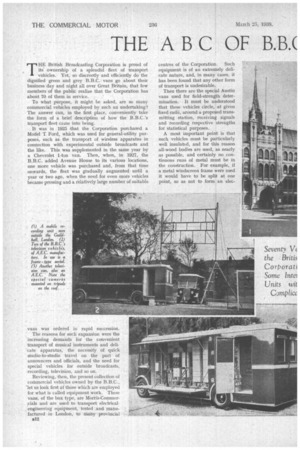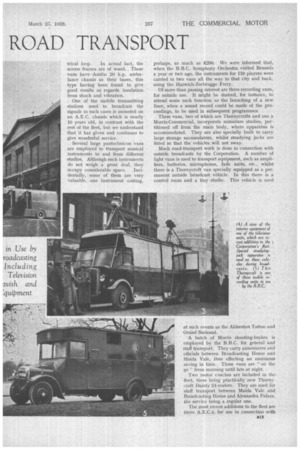THE A B C OF B.B.( ROAD TRANSPORT
Page 46

Page 47

Page 48

If you've noticed an error in this article please click here to report it so we can fix it.
THE British Broadcasting Corporation is proud of its ownership of a splendid fleet of transport vehicles. Yet, so discreetly and efficiently do the dignified green and grey B.B.C. vans go about their business day and night all over Great Britain, that few members of the public realize that the Corporation has
about 70 of them in service. .
To what purpose, it might be asked, are so many commercial vehicles employed by such an undertaking? The answer can, in the first place, conveniently take the form of a brief description of how the B.B.C. 's transport fleet came into being.
It was in 1925 that the Corporation purchased a Model T Ford, which was used for general-utility purposes., such as the transport of wireless apparatus in connection with experimental outside broadcasts and the like. This was supplemented in the same year by a Chevrolet 1-ton van. Then, when, in 1927, the B.B.C. added Avenue House to its various locations, one more vehicle was purchased and, from that time onwards, the fleet was gradually augmented until a year or two ago, when the need for even more vehicles became pressing and a relatively large number of suitable vans was ordered in rapid succession.
• The reasons for such expansion were the increasing demands for the convenient transport of musical instruments and delicate apparatus, the necessity of quick studio-to-studio travel on the part of announcers and officials, and the need for special vehicles for outside broadcasts, .recording, television, and so on.
Reviewing, then, the present collection of commercial vehicles owned by the B.B.C., 'let us look first at those which are employed for what is called equipment work. These vans, of the box type, are Morria-Commer,cials and are used to transport electricalengineering equipment, tested and manufactured in London, to many 'provincial
912 centres of the Corporation. Such equipment is of an extremely delicate nature, and, in many cases, it has been found that any other form of transport is undesirable.
Then there are the special Austin vans used for field-strength determination. It must be understood that these vehicles circle, at given fixed radii, around a proposed transmitting station, receiving signals and recording respective strengths for statistical purposes.
A most important point is that such vehicles must be particularly well insulated, and for this reason all-wood bodies are used, as nearly as possible, and certainly no continuous runs of metal must be in the construction. For example, if a metal windscreen frame were used it would have to be split at one point, so as not to form an elec. trical loop. In actual fact, the screen frames are of wood.. These vans have -Austin 20 h.p. ambulance chassis as their bases, this type having been found to give good results as regards insulation from shock and vibration.
One of the mobile transmitting stations used to broadcast the signals in such cases is mounted on an A.E.C. chassis which is nearly 10 years old, in contrast with the rest of the fleet, but we understand that it has given and continues to give wonderful service.
Several large pantechnicon vans are employed to transport musical instruments to and from different studios. Although such instruments do not weigh a great deal, they
occupy considerable space. Incidentally, some of them are very valuable, one instrument costing.
perhaps, as much as £200. We were informed that, when the B.B.C. Symphony Orchestra visited Brussels a year or twb ago, the instruments for 119 players were carried in two vans all the way to that city and back, using the Harwich-Zeebrugge Ferry.
Of more than passing interest are three recording vans, for outside use. It might be desired, for instance, to attend some such function as the launching of a new liner, when a sound record could be made of the proceedings, to be used in subsequent programmes.
These vans, two of which are Thornycrofts and one a Morris-Commercial, incorporate miniature studios, partitioned off from the main body, where apparatus is accommodated. They are also specially built to carry large storage accumulators, whilst steadying jacks are fitted so that the vehicles will not sway.
Much road-transport work is done in connection with outside broadcasts by the Corporation. A number of light vans is used to transport equipment, such as amplifiers, batteries, microphones, fade units, etc., whilst there is a Thornycroft van specially equipped as a permanent outside broadcast vehicle. In this there is a control room and a tiny studio. This vehicle is used at such events as the Aldershot Tattoo and Grand National.
A batch of Morris shooting-brakes is employed by the B.B.C. for general and staff transport. They carry announcers and officials between Broadcasting House and Maida Vale, thus effecting an enormous saving in time. These vans are "on the go" from morning until late at night.
Two motor coaches are included in the. fleet, these being practically new Thornycroft Dainty 24-seaters. They are used for staff transport between Maida Vale and Broadcasting House and Alexandra Palace, the service being a regular one.
The most recent additions to the fleet are three. A.E.C.s, for use in connection with television. Each has a definite function, there being the scanner (or mobile control room), the transmitter, and the power vehicle.
The power vehicle, which, incidentally, weighs ill tons, is, in common with the other two, an A.E.C. Regal equipped with springs as used on the Regent model. This deviation from standard specification in the matter of suspension has been found most effective. Largely accounting for the high weight of this particular vehicle is an extra power unit, identical with that which chives the chassis, but mounted behind the driver's cab, and providing a 230-volt threephase supply of current to the other two vans.
A most important point is that the speed of this second engine must he kept as nearly constant as possible, and for this reason an elaborate and cleverly constructed governor is fitted, whilst included in the electrical equipment of the van is a complicated voltagecontrol unit as a kind of " double check."
The scanner, as has already been mentioned, is virtually a mobile control room, whilst the transmitter is of the ultra.short-wave type. None of the vehicles weighs less than 8 tons and all of them have steadying jacks.
It is proposed to add a new television van to the fleet shortly, and this will carry a Merryweather fire-escape, to the top of which it will be possible to attach the aerial. To have the latter as high as possible is highly desirable for television.
There are a few other points of rather more general interest in connection with the Corporation's transport section. The annual mileage for the whole fleet is in the neighbourhood of 800,000, and a high degree of reliability is vital on the part of every vehicle. The public has no patience with a programme which does not start to time, whether the original cause has been a broken connectingrod or anything else ! There are several pits in the garage and up-to-date washing facilities. Scrupulous cleanliness is evident.
The drivers, all of whom are uniformed, are experienced men. A restroom is provided for them at Avenue House, and there is a canteen on the premises. They must be available at practically any hour, as a great deal of night work is involved. In charge of the transport section, as manager, is Mr. J. F. Churchill.
In conclusion, we would mention that although the British Broadcasting Corporation runs such a comprehensive fleet of vehicles, in absolutely tip-top condition and for the most part right up to date, expansion is even now being considered and every day brings a little more need for other vehicles to accord with increasing development.




























































































